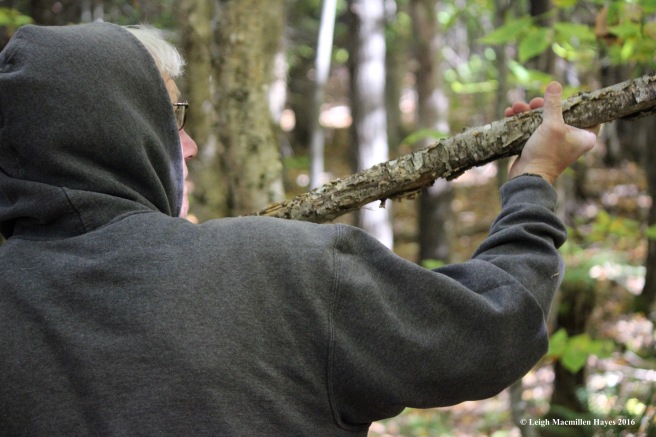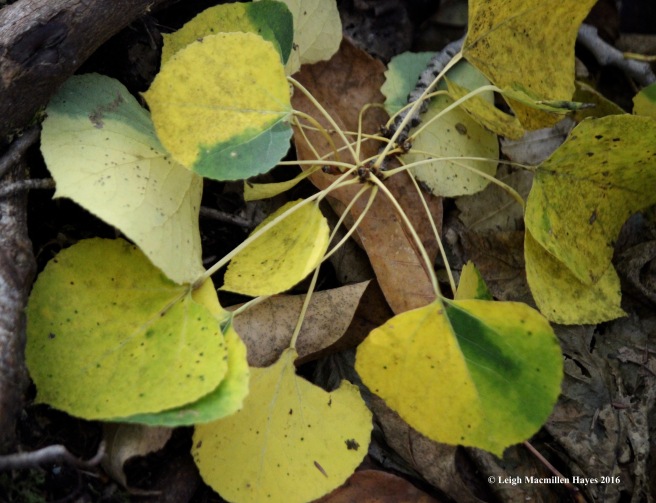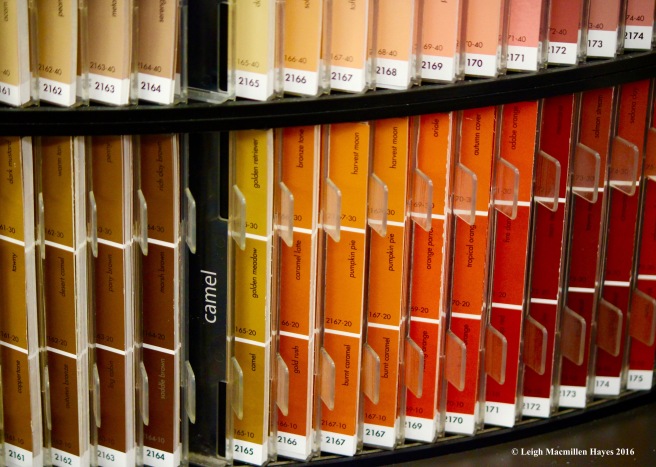The fleeting fall foliage offered the backdrop for our afternoon Mondate.

We started with a stop at Five Fields Farm to purchase a pumpkin and enjoy a chat with owners Tom and June Gyger.

Their orchard overlooks Holt Pond, that speck of blue among the trees. Because of this year’s drought, the water is lower than ever, but Tom pointed out that during heavy rainstorms they’ve often watched it quickly fill and then lower as the water pours in and then slowly flows down the Muddy River. We need such a storm.

In fact, once we got onto the trail, my guy tested a bridge he’d built in the spring–noting that currently it’s useless because no water flowed below.

We continued on, turning our hike into a trail clearing activity because this is a trail we steward for Lakes Environmental Association. A few blow downs were easily cleared–by my guy. I worked as well–documenting his good deeds.

But really, it was the color that drew our attention.

At our feet, a rich carpet covered the forest floor.

It’s vibrant variety was pre-determined by the species. Red maple leaves offer shades of red or scarlet, sugar maple leaves vary from brilliant orange to fiery red to yellow, while striped maple, quaking aspen and birch feature only yellow. Ash leaves range from yellow to magenta and beech offers up a golden bronze.

So, how does it work? It’s been dry and many thought that would mean a lack of color this fall. Yes, some trees will dry up and their leaves wither and fall. But for most, it’s a different story as old as time.

During the spring and summer the leaves worked as food-processors for their trees. Their numerous cells contain chlorophyll or the green coloration. The chlorophyll absorbed energy from the sunlight, which it then used to change carbon dioxide and water to sugars and starch (think carbohydrates).

But, also at work alongside the green pigment, yellow and orange carotenoids. As you can see with these quaking aspen leaves, the carotenoids are masked by the greater amount of green coloring for most of their season.

With the change in daylight hours and temperature, the leaves go on strike from processing food. And thus, the chlorophyll breaks down, green color begins to disappear and the yellowish color becomes visible to our delight.

At the same time, other chemical changes occur that cause the formation of more pigments from red . . .

to purple. The red pigment called anthocyanin forms.

It’s like being in nature’s paint store.

And I have to admit that it occurred to me I should spend some time sorting leaves by color and trying to match them to paint chips so I could better describe the gems before me.

OK, so I didn’t dwell on that thought for too long, just long enough to realize that it would need to be a quick assessment before the leaves dry up and all become a shade of brown.

At last we reached a vantage point from which to view the pond. I often stand across the way on the quaking bog boardwalk, so looking back provided a different perspective.

And those swamp maples–oh my!

For this beautiful display to occur, we must have warm sunny days followed by cool nights. The sugar is made in the leaves during the day, but those cool nights trap it there, preventing it from moving into the tree.

Not only do the colors vary, but the degree of color may also be different from tree to tree or even on one tree. Direct exposure to the sun may turn leaves red on one side of a tree and they may be yellow on the shady side.

As for clouds and rain, too much in the fall means less red (a bright side of the drought). On those types of days it also tends to be warmer at night, thus changing up the process and providing duller colors. Not so this year, thankfully.

There was nothing dull about what we saw today, including the presentation of fallen leaves, some captured by their evergreen comrades.

A few dangled like ornaments hung by spiders.

Others held on precariously, attached only by a few points.

And even others portrayed a shadow show.

At last we reached a small stream, our turn-around point, where all gathered to show off their glory.

We took one last look at the pond while making our way back. And what to my wondering eyes should appear–Nessie. Or maybe I should name her Holtie, the Holt Pond Monster! Do you see her?
My guy–he chuckled at me. He often does that. It’s OK. I know what I saw.
You might say our Mondates are always colorful, but today’s was especially color-filled as we celebrated the work of the leaves.

Sighted Nessie right off! Colorful walk and great way to identify color in the leaves and give those paint chips an educational purpose. Love it!
LikeLiked by 1 person
Hardware store owner meets teacher who gets turned on by nature equals oy vey!
LikeLike
Enjoyed my walk with you, seeing all these beautiful colors.Ursula >
LikeLiked by 1 person
Thanks for coming along once again, Ursula. It may not be the orchids, but the colors are equally beautiful.
LikeLike
Gorgeous colors! You are having a beautiful fall!
LikeLiked by 1 person
Indeed we are–thanks to the drought. Who knew!
LikeLike